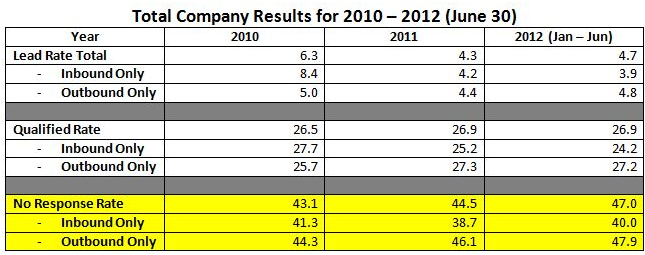This is the third in a series of four blogs about lead generation, marketing and sales metrics, and proverbs.
The phrase, "A watched pot never boils" contains a warning against giving in to impatience; it'll do you no good at all and will only serve to make you and those around you uncomfortable. A pot of water is going to boil in exactly the same length of time whether or not you watch it, but if you are so impatient that you need to keep watching in the hope it will boil more quickly it will seem to take forever to come to boiling point.
In the last blog we talked about qualified rates. This time we are going to talk about managing the “No Response” rate and the importance of having patience when it comes to working prospects—including resting them and then recycling re-segmented prospects to improve overall results.

- Based on over 60,000 completed company dispositions per year (annualized for 2012).
- Leads and expected metrics are defined in carefully created client program plans and lead rates are impacted (particularly in 2010) by the mix and quality of inbound dispositions.
- Qualified Rate includes leads, pipeline (specific action required by PointClear) and nurtures (qualified companies with no immediate pain/need or interest).
- No Response means we completed a multi-touch, multi-media touch cycle without reaching the prospect or their reaching back out to us. As info, 20-30% of opportunities or leads developed for clients are as the result of a call or email back due to our outbound voicemails messages followed by outbound emails.
A few years ago we had a client that sold business process outsourcing services (or BPO) to large companies. One program in particular targeted the CFO at the top fifty utilities in North America. On the 42nd touch, the CFO of what was then the fourth largest utility called our associate back and said: “Don’t stop calling me, you’re my conscience. I want to talk to you but I have been extremely busy. Call me back in two weeks on Tuesday at 10:00 AM and I will take the call.” Later we found out that he had saved a voice mail, two emails and an article in an industry magazine we had sent him. The forty-two touches took place over a ninety day period. They included voicemail, email and one magazine we sent overnight because it had the picture of a CFO at a utility company that was a client of our client’s. The winning (42nd touch) was during what was the last cycle of contact we planned to execute on this prospect. Prospects are “rested” between cycles for a period of time that depends on their position, the size of the company… In this case we were on our fourth cycle of contact. Oh, and by the way, this opportunity closed for $1,000,000,000 in five months for our client (a global BPO company).
If we treated this prospect like a “watched pot”, we would have done what so many others do which is to invest too many touches too soon (and alienate the prospect). That is assuming there is a filter between raw lead generation and sending those leads to sales (if not, it is more likely that too few touches would have been invested and the opportunity would have been wasted).
Managing “No Response” dispositions is not an art, it’s a science. Just like water has a boiling point, there are an exact number of touches that optimize a list and cutting off at that number of touches means that you will reach some companies and not reach others. The key, though, is to re-segment based on each cycle’s results and continue to improve the prospect list. The objective is to always go after what I call the less expensive barrels of oil, continuing to identify the more expensive barrels of oil that must be prospected less expensively with other media (such as marketing automation).
Rule of thumb, a touch cycle generally contains 6 – 12 touches and you reach a point of diminishing return after about 3 – 4 cycles of contact. Also, while this may not seem intuitive, our experience over the years has shown that the more senior level decisions makers (C-level, Sr. VP level) are 2.5 times MORE responsive to quality multi-touch, multi-media and multi-cycle campaigns than are their more junior counter-parts.
The definition of a proverb is: a short and expressive saying in common use, which is recognized as conveying some accepted truth or useful advice. If you want to read more about proverbs and their origins, click here.
| B2B Sales Lead Management, Marketing and Sales Metrics, and Proverbs—The Four-Part series: Part 1: B2B Lead Generation: Are You Killing the Golden Goose? Part 2: B2B Sales Lead Management: A Bird in Hand is Worth Two in the Bush This blog is Part 3: Lead Generation: A Watched Pot Never Boils Part 4: Sales Leads: Don't Look a Gift Horse in the Mouth |
By Dan McDade
Topics: Lead Generation, Lead Nurturing





